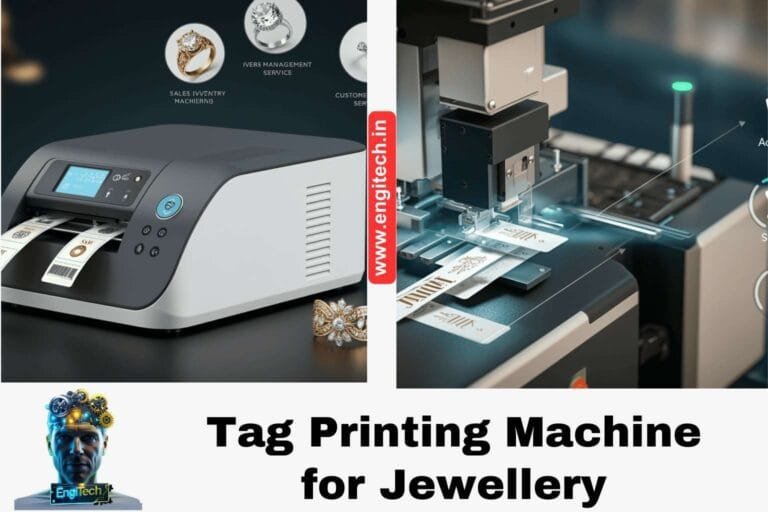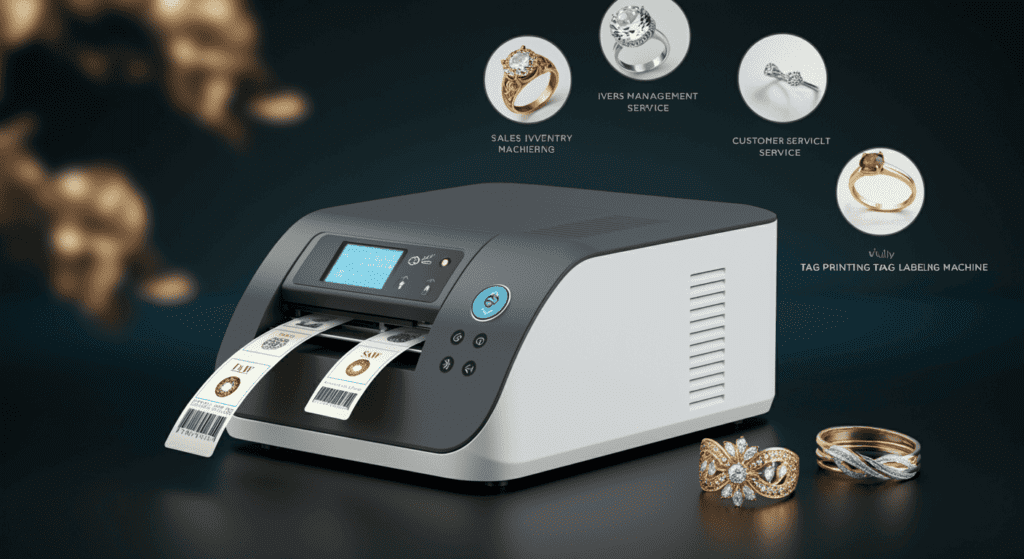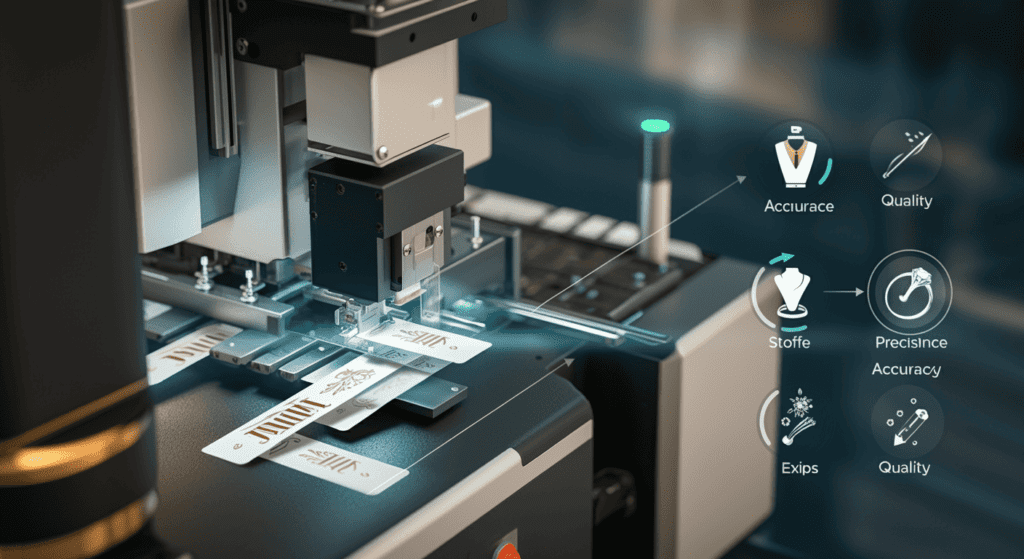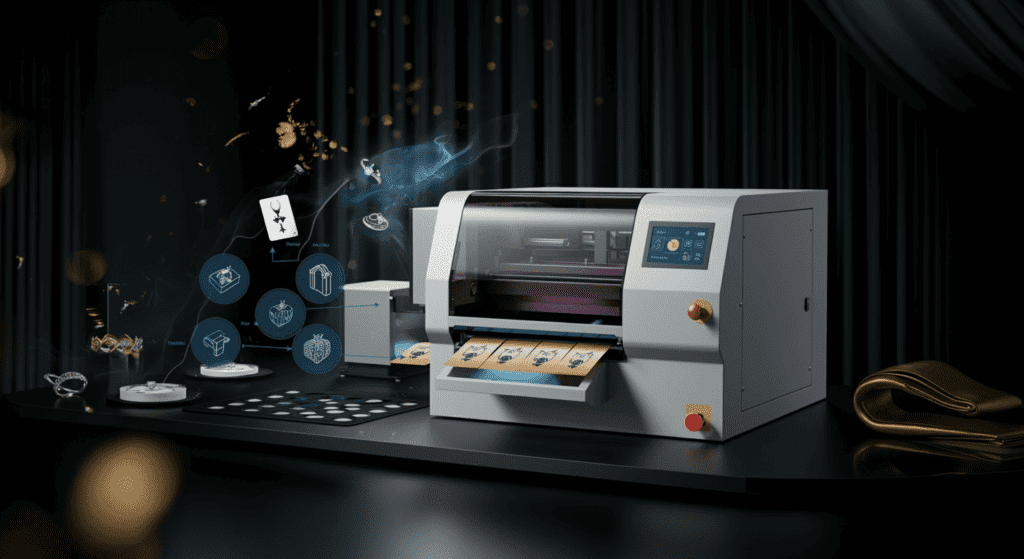
In the fast-paced world of jewelry retail, every detail counts. From the brilliance of diamonds to the sheen of precious metals, your customers expect a luxurious experience at every touchpoint—including the tags on each item. One of the most overlooked yet impactful ways to enhance your brand image is by investing in a reliable tag printing machine for jewellery. In this comprehensive guide, you’ll discover how these specialized devices can revolutionize your store operations, boost your brand’s credibility, and ensure compliance with industry standards.
Whether you’re a boutique jewelry shop owner or part of a large retail chain, mastering the art and science of jewelry tag printing can set you apart in a crowded marketplace. By the end of this guide, you’ll know exactly what to look for in a tag printer, how to overcome common challenges, and how to optimize your new system to impress customers and drive higher sales.
Table of Contents
Understanding the Importance of Jewelry Tagging
Why Small Details Have a Big Impact
When your customers browse display cases, they’re not just looking at the sparkle of the gems; they’re assessing your store’s professionalism. A well-designed jewelry tag does more than list prices—it showcases branding, provides essential product information, and reassures buyers that your jewelry is authentic and well-documented.
In many cases, the tag is the first element a shopper examines after selecting a piece of jewelry. If the label looks flimsy or poorly printed, it can diminish a customer’s trust. Conversely, a neat, precisely printed tag with crisp text and imagery can reinforce a sense of quality. This is why a tag printing machine for jewellery is critical: it delivers consistent, high-quality tags that support your brand’s reputation.
Balancing Aesthetics with Compliance
Jewelry tags aren’t just about aesthetics. Regulatory bodies often require specific disclosures about materials, weights, and country of origin. Failing to display this information accurately can lead to legal complications and customer dissatisfaction. A specialized jewelry tag printer helps ensure each piece of information is printed legibly, enabling you to meet regulations while maintaining a sophisticated look and feel.
Boosting Operational Efficiency
From independent jewelers to national chains, every retailer struggles with the same question: How can we boost efficiency without compromising on quality? Handwriting or manually tagging items is time-consuming, prone to error, and often results in inconsistent labels. An automated tag printing machine for jewellery takes care of the intricate details—like printing barcodes, product codes, prices, and even your logo—within seconds. This speeds up your workflow and provides a level of consistency and accuracy that manual methods can’t match.

The Evolution of Tag Printing Machines
From Manual Labels to Automated Solutions
Historically, many jewelers relied on handwritten labels or basic office printers to create tags. While sufficient for very small-scale operations, these methods became problematic for larger inventories and for retailers wanting a polished, professional image. The technological transition to specialized tag printers provided a leap forward in accuracy, speed, and style.
Over time, manufacturers recognized the unique needs of the jewelry sector, such as small printing surfaces, durable materials, and tamper-resistant adhesives. This led to specialized devices engineered specifically for tagging delicate pieces. Thanks to modern advancements, you can now print high-resolution tags on heat-resistant or tear-resistant materials that withstand daily handling.
Why Specialized Machines Matter
You might wonder: Can’t a standard label printer handle jewelry tags? Technically, a regular label printer can produce some form of tag, but it often lacks the precision, materials compatibility, and specialized features needed for high-end jewelry. Standard office printers aren’t designed to print tiny fonts clearly or handle unique tag shapes. Furthermore, they usually don’t offer specialized ribbons or adhesives tailored for fine jewelry.
A tag printing machine for jewellery addresses these issues directly, providing:
- High-Resolution Printing: Ensures brand logos and text look sharp, even at small sizes.
- Compatible Materials: Works with water-resistant, tear-resistant, or heat-resistant tags.
- Jewelry-Focused Design Software: Offers templates and layout options specifically for jewelry retailers.
- Barcode Integration: Simplifies inventory management and fraud prevention.
Key Features to Consider in a Tag Printing Machine
Selecting a tag printing machine for jewellery isn’t a decision to take lightly. Here are some core features you should evaluate to ensure you make the right investment:
Print Resolution and Clarity
High-resolution printing is non-negotiable. Jewelry tags often need to fit an array of information—brand names, product codes, metal purity details, carat weights—in a small space. A printer with at least 300 dpi (dots per inch) is recommended for crisp, easily legible text. Some top-tier models even offer 600 dpi for extremely fine details, perfect if you plan to print logos or intricate design elements.
Speed and Efficiency
Time is money, especially in retail. A printer that can quickly produce dozens of tags in a single batch will streamline your workflow and free up staff for other tasks. Look for a printer that can handle multiple types of tags or labels without constant reconfiguration. This adaptability allows you to switch seamlessly between different jewelry lines, seasonal promotions, or special product launches.
Durability of Printed Tags
Your customers handle jewelry pieces to examine them closely, so tags must remain intact and legible under frequent contact. Thermal transfer printing is often the preferred technology for jewelry tags because it uses a ribbon and heat to transfer ink onto a specialized tag substrate. This method offers long-lasting, smudge-proof prints compared to direct thermal printing or inkjet alternatives.
Material Compatibility
Different jewelry items require different types of tags, whether they’re loop tags for delicate chains or barbell tags for rings and earrings. Before you purchase a tag printing machine, verify that it supports the variety of tag materials you plan to use—synthetic, plastic, or paper-based. Some printers come with adjustable sensors and feeders designed specifically to accommodate these specialized tag shapes.
Software and Connectivity
User-friendly software can be a game-changer, especially if you need to input product data, generate barcodes, or design brand logos. Advanced tag printers often come with complementary software or are compatible with third-party design tools. Look for a system that integrates smoothly with your existing inventory management or point-of-sale (POS) software. Connectivity options—such as USB, Ethernet, or wireless—are also vital for a hassle-free experience.
Ease of Use and Maintenance
A steep learning curve can slow you down. The best machines offer intuitive interfaces, allowing staff to generate tags with minimal training. Removable printheads or easily replaceable ribbons make maintenance far simpler. If you plan to print large volumes of tags, invest in a model that’s built to withstand heavy usage without frequent breakdowns.
Cost Considerations
Pricing can range widely, from budget-friendly options for small boutiques to industrial-grade printers that can handle thousands of tags per hour. While cost is important, it shouldn’t be your only deciding factor. Investing in a higher-quality model often proves more cost-effective in the long run due to fewer maintenance issues, higher print quality, and faster throughput.
How a Tag Printing Machine Boosts Retail Efficiency
Reducing overhead, optimizing labor, and improving customer satisfaction are at the heart of any successful retail operation. Here’s how a tag printing machine for jewellery achieves these goals:
- Consistent Labeling for Brand Integrity
A single machine provides uniformity across all your tags, ensuring every piece in your collection reflects your brand’s aesthetic. Consistency not only elevates your store’s presentation but also builds trust in buyers’ minds. - Real-Time Inventory Updates
Many tag printing systems let you incorporate barcodes or RFID chips directly into your tags. This means you can track stock levels in real-time and reduce the risk of inventory discrepancies. In an era when omnichannel retail is the norm, having accurate data is crucial for reordering and fulfilling online and in-store demands. - Time Savings
Handwritten tags are notorious for taking up valuable staff hours and causing frequent mistakes. Automated tag printers work swiftly and generate fewer labeling errors, freeing your staff to focus on more profitable tasks like sales, customer service, or product curation. - Enhanced Customer Experience
A cluttered or unprofessional tag can deter even the most enthusiastic buyers. When a tag is clear, accurate, and visually appealing, customers feel reassured about the authenticity and quality of your products.

Step-by-Step Guide to Using a Tag Printing Machine for Jewellery
If you’re considering or have just purchased a tag printing machine for jewellery, here’s a clear roadmap to get you started:
Step 1 – Setup and Calibration
- Unboxing and Inspection: Carefully remove the printer from its packaging and check for any shipping damage.
- Installing Software: Follow the manufacturer’s instructions to install necessary drivers or design software on your computer.
- Loading Materials: Insert the ribbon (for thermal transfer printers) and load the specialized tags. Make sure the sensors and feeders are adjusted to the correct dimensions.
Step 2 – Designing the Tag Layout
- Logo Placement: Upload your brand’s logo into the design software to appear prominently on the tag.
- Text Fields and Font Selection: Input essential information like product codes, metal purity, or price. Choose a legible font size that fits comfortably on the tag.
- Barcodes or QR Codes: If you use a barcode system, integrate it into your layout. This helps in streamlining inventory checks and sales processes.
Step 3 – Printing and Quality Checks
- Test Print: Always start with a single test tag to check alignment, clarity, and content accuracy.
- Batch Printing: Once satisfied with the test print, proceed to produce tags in batches. Keep an eye on print quality to ensure each tag is crisp and properly aligned.
- Troubleshooting: If you notice smudges or fading, adjust print settings or confirm that you’re using a compatible ribbon-tag combination.
Step 4 – Attaching the Tags to Jewelry
- Selecting Attachment Method: For rings and earrings, barbell tags are typical; for necklaces or bracelets, loop tags may be preferable.
- Sanitizing the Jewelry and Tags: Use a soft cloth or recommended jewelry cleaner to remove fingerprints from both the item and the tag.
- Applying the Tag: Carefully attach the tag without scratching the metal or gemstone. Ensure it’s visible but not obstructive.
Common Challenges and How to Overcome Them
Even the best tag printing machine for jewellery can come with a few pitfalls. Here’s how to navigate them:
- Printer Jams and Material Misfeeds
- Solution: Always use high-quality, manufacturer-approved tag materials. Clean the machine regularly to clear dust or residue.
- Fuzzy or Faint Prints
- Solution: Check your ribbon compatibility and printer settings. Using the wrong ribbon-type or sub-optimal heat settings can result in blurred text.
- Misaligned Text
- Solution: Calibrate the printer’s sensors and adjust layout settings within the design software. Run a test print after each tweak.
- Tag Adhesive Not Sticking
- Solution: Some tags have weaker adhesives; switch to a higher-grade adhesive or use loop-style tags for chains and delicate pieces.
- Software Compatibility Issues
- Solution: Keep both your printer drivers and design software updated. Many manufacturers offer comprehensive support or patches to fix compatibility hiccups.

Frequently Asked Questions (FAQs)
1. Can I use a standard office printer for jewelry tags?
Technically, yes, but you won’t achieve the level of precision, quality, or durability required in a jewelry setting. A dedicated tag printing machine for jewellery offers specialized features like high-resolution output, unique tag shapes, and robust print materials that standard printers simply can’t replicate.
2. What materials are best for jewelry tags?
Synthetic materials, such as polypropylene or polyester-based tags, are popular because they resist tearing, water, and smudging. Paper-based tags can work for less expensive items but may not hold up in a busy retail environment. Always ensure your printer supports the materials you plan to use.
3. How do I integrate barcodes into jewelry tags?
Most specialized tag printing machines and software suites allow you to generate and print barcodes directly. You simply insert the barcode field into your tag design, choose the barcode type (e.g., Code 128, UPC, or QR code), and ensure the printer is calibrated for that size.
4. Are thermal transfer ribbons expensive?
They can be slightly more expensive than ink cartridges for standard printers, but they also produce longer-lasting prints that won’t smear. Most retailers find the overall cost to be justified by the enhanced durability and professional appearance of thermal transfer tags.
5. How often do I need to replace the printhead?
Printhead longevity depends on usage volume and maintenance. Some high-quality printheads can last for millions of prints if you regularly clean them and use high-grade ribbons and tags. Refer to your printer’s manual for routine maintenance guidelines.
Real-World Success Stories
How Jewelers Are Transforming Their Branding
- Boutique Retailer in New York City
A small, family-owned jewelry store in NYC upgraded from handwritten tags to a specialized tag printer. Within weeks, they noticed fewer labeling errors and smoother sales transactions. Customers also commented on the new polished look, enhancing the boutique’s upmarket positioning. - Regional Chain Across the Midwest
A multi-store chain implemented centralized printing for all their locations using advanced software integration. By adopting barcoded tags, they improved inventory accuracy by 30% and cut down on internal shrinkage. The standardization also allowed them to roll out flash sales more efficiently, simply by printing new promotional tags in bulk.
These success stories highlight a common theme: investing in a tag printing machine for jewellery not only refines your store’s image but also has real, measurable impacts on sales performance and operational efficiency.
Future Trends in Jewelry Tagging
As technology evolves, jewelry tagging stands on the brink of even more innovation. Here are some trends to keep an eye on:
- RFID Integration
Radio Frequency Identification (RFID) tags make inventory tracking and loss prevention incredibly efficient. Although still in a higher price bracket, RFID solutions are expected to become increasingly cost-effective, bringing advanced tracking to more retailers. - Smartphone-Readable Codes
QR codes and NFC tags may become more prevalent, allowing customers to scan codes with their smartphones to access product origin stories, certification details, or even personalized video content about a piece of jewelry. - Eco-Friendly Tag Materials
Sustainability is now a key focus in consumer purchasing decisions. Biodegradable or recyclable tag materials are growing in popularity, and future tag printers may adapt to handle an even wider range of eco-friendly substrates.
Staying ahead of these trends not only positions you as a forward-thinking retailer but also allows you to offer innovative customer experiences that strengthen brand loyalty.
Conclusion: Elevate Your Store’s Image with the Right Tag Printing Machine
Every piece of jewelry you showcase tells a story—one of craftsmanship, heritage, and value. Don’t let subpar tags undermine that narrative. By selecting a high-quality tag printing machine for jewellery and investing the time to set it up correctly, you demonstrate a commitment to excellence that resonates deeply with your customers.
From enhanced branding to crystal-clear product information, the benefits are wide-ranging. And as we’ve seen through real-world success stories, the impact on both your bottom line and your brand reputation can be significant. By optimizing your tagging process, you’re not just printing labels—you’re crafting a cohesive, trustworthy shopping experience that customers will remember long after they leave your store.
Ready to take the next step? Consider how an advanced tag printing system can integrate with your current operations. Think about the materials you’ll use, the software you’ll rely on, and the unique branding elements that will set your store apart. Then, make the leap. Your customers—and your future bottom line—will thank you.
Stay Connected with EngiTech
EngiTech is your trusted source for in-depth knowledge on industrial mechanical engineering machines and technologies. Stay ahead with the latest innovations, expert insights, and practical guides designed to help you make informed decisions for your business and engineering needs. Join our growing community of professionals and industry leaders to stay updated and competitive in the ever-evolving world of industrial technology.